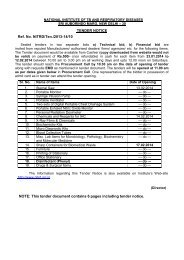October - LRS Institute of Tuberculosis & Respiratory Diseases
October - LRS Institute of Tuberculosis & Respiratory Diseases
October - LRS Institute of Tuberculosis & Respiratory Diseases
You also want an ePaper? Increase the reach of your titles
YUMPU automatically turns print PDFs into web optimized ePapers that Google loves.
NON-TUBERCULOUS LUNG MYCOBACTERIOSIS IN GUJARAT<br />
177<br />
casual isolates, giving a background isolation rate <strong>of</strong> tuberculous mycobacteriosis was too small to<br />
0.25 %.<br />
indicate the prevalence <strong>of</strong> particular type <strong>of</strong> species.<br />
However, M. Kansasii and M. fortuitum were found<br />
Discussion<br />
to cause the disease, and it was noticable. that no M.<br />
avium-intracellulare strain was isolated. In other<br />
Increasing interest <strong>of</strong> mycobacteriologists in the parts <strong>of</strong> India, however, isolation <strong>of</strong> M. aviumintracellulare<br />
from sputum has been reported<br />
non-tuberculous mycobacteria has improved our<br />
knowledge about the incidence <strong>of</strong> lung disease due to (Kotian et al, 1981; Das et al, 1982; Paramsivan et al,<br />
NTM. Data on the frequency <strong>of</strong> lung disease due to 1985).<br />
NTM are available for several countries. The In United States and Japan, it has been noticed<br />
frequency is 4.6% in Western Australia (Carruthers that as the number <strong>of</strong> cases <strong>of</strong> tuberculosis<br />
and Edwards, 1955), 0.1 % in South Africa (Stottmeir,<br />
Kleeberg and Blockbergen, 1966), 2.8%in species increases (Good, 1979; Mycobateriosis<br />
declines, disease due to other mycro baterial<br />
Canada (Gale, 1976), 1.7% in Japan). (Tsukamura et Research Group <strong>of</strong> tha Japanese National Chest<br />
al, 1981), 3.3% in Rhodesia (Tsukamura et al, 1972), Hospital, 1983). In Gujarat, with a relatively high<br />
1 to 30%, in various locations <strong>of</strong> United States morbidity <strong>of</strong> tuberculosis (about 1.5 %-<br />
(Wolinsky, 1979). In India, the isolation rate varies unpublished date from <strong>Tuberculosis</strong> Research<br />
from 0.7 to 34Y. (Thomas et al, 1961; Patel, D’ Souza Centre, Amargadh), the prevalence <strong>of</strong> lung disease<br />
and Sayed, 1966; Choudhri et al, 1979; Ramakrishnan,<br />
1981; Kotian et al, 1981; Das et al, 1982;<br />
due to NTM appears to be very low.<br />
Hardas and Jayaraman, 1984; Paramsivan et al, 1985).<br />
However, most <strong>of</strong> the reports from India range from Acknowledgements<br />
less than 1.0 Y. to as high as 13.1 %, except one, We are grateful to Dr. J. Kenneth McClatchy,<br />
which reports 34 % isolation rate (Pate)., D’ Souza Ph.D., Curator, Trudeau Mycobaeterial Culture<br />
and Sayed, . 1966), which was unusually high. In Collection, National Jewish Hospital and Research<br />
many reports, there is no distinction between casual Centre, Denver, Colorado, U.S.A. for providing us<br />
isolations and actual cases <strong>of</strong> disease, or mycobaterial standard mycobaterial strains, and to Mr. S.D.<br />
strains were not identified up to the species-level. Andharia, senior laboratory technician,<br />
Merely, the report <strong>of</strong> isolation rate or number <strong>of</strong> <strong>Tuberculosis</strong> Research Centre, Amargadh, for his<br />
mycobacteria) isolates does not give an exact idea <strong>of</strong> help throughout the study.<br />
the clinical significance <strong>of</strong> various species <strong>of</strong><br />
potentially pathogenic non-tuberculous mycobacteria.<br />
In the present study, an isolation rate <strong>of</strong> 0-15%<br />
has been obtained, which is quite low, when<br />
compared with other reports. Temporary<br />
colonization <strong>of</strong> NTM in the respiratory tract is not<br />
uncommon, and about 5 % <strong>of</strong> the healthy<br />
individuals were found to have such colonization<br />
(Kotian et al, 1983). In the present study, all the<br />
patients were known cases <strong>of</strong> pulmonary diseases<br />
and were taking anti-tuberculous chemotherapy and<br />
this may be the reason for the supression <strong>of</strong><br />
temporary colonization and hence, very low casual<br />
isolation rate <strong>of</strong> 0.25 % only.<br />
Geographic differences in the occurrence <strong>of</strong><br />
disease due to a particular non-tuberculous<br />
mycobacteria) species have been reported. In<br />
Europe and the United States, about 50 % <strong>of</strong> all<br />
isolates <strong>of</strong> non-tuberculous mycobacteria obtained<br />
from the patients in <strong>Tuberculosis</strong> Hospital are M.<br />
Kansasii. In contrast, M. avium-intracellulare strains<br />
are in the majority among isolates in Japan, Rhodesia<br />
and Australia (as quoted by Tsukamura et al, 1981).<br />
In the present study, the number <strong>of</strong> cases <strong>of</strong> non-<br />
REFERENCES<br />
American Thoracic Society, Diagnostic Standards<br />
and Classification <strong>of</strong> <strong>Tuberculosis</strong> and other<br />
mycobacterial disease. American Lung<br />
Association, New York, 1974.<br />
Carruthers, K.J.M. and Edwards, F.G.B., Atypical<br />
mycobacteria in Western Australia. Am. Rev.<br />
Resp. Dis. 1955, 91, 887.<br />
Choudhri, D.S., Dube; M.K., Purohit, S.D., Dube, S.<br />
The prevalence <strong>of</strong> anonymous mycobacteria in<br />
both resistant as well as fresh cases <strong>of</strong> pulmonary<br />
tuberculosis in the local population <strong>of</strong> South east<br />
Rajasthan. Ind. J. Path. Micro. 1979, 22, 162.<br />
Das, B.K., Sharma, V.K., Rao Bhanu, L.N. Saxena,<br />
S.N., and Bhardwai, B.K. Characterization <strong>of</strong><br />
mycobacteria) strains from clinical specimens.<br />
Ind. J. Path. Microbiol. 1982, 25, 19.<br />
Gale, G.L., Atypical mycobacteria in a<strong>Tuberculosis</strong><br />
hospital. Can. Med. Ass. J. 1976, 114, 612.<br />
Good, R.C. Non-tuberculous mycobacteria. Clin.<br />
Microbiol. Newsletter, 1979,1(20),1.<br />
Hardas, U.D. nd Jayaraman,V.S.Differential identification<br />
<strong>of</strong> mycobacteria, I nd J. Tub. 1 . 984, 31, 11.
















